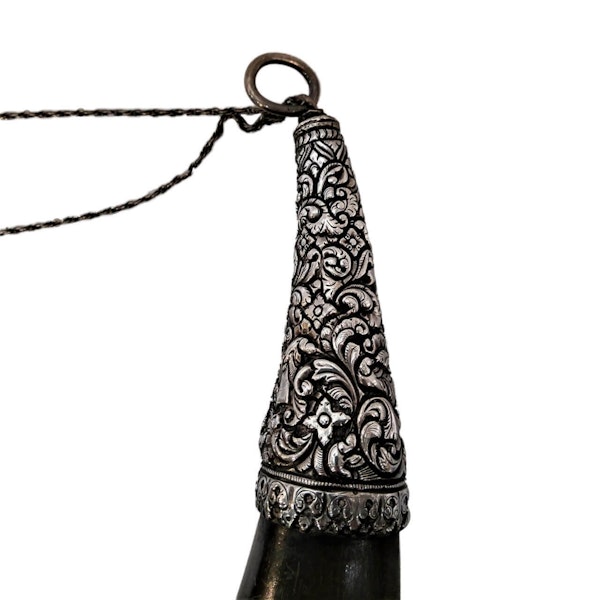Antique Indian Silver Mounted Horn, Trichonopoly, India – Late 19th C
Antique Indian Silver Mounted Horn, Trichonopoly, India – Late 19th C
£3,600.00
Description
This magnificent antique Indian silver mounted horn has a pleasing crescent shape and is well proportioned. The translucent deep golden or tawny brown horn shades to a much darker brown towards the tip. The horn’s very large size indicates that it would have come from an old buffalo and the surface of the horn would have been finely polished before mounting with silver. A silver chain has been threaded through a ring mounted at the tip of the horn and another which pierces the rim to the inside curve of the horn, probably to facilitate display.
The silver mountings are of heavy gauge and the ornamentation uses repousse and chased techniques in the distinctive regional style of Trichonopoly. Just below the rim, a silver band with raised and ornamented edges features a repeating pattern of caparisoned elephants separated by vegetation. The animals are well modelled and the details have been finely chased. The area just above the tip of the horn has been covered by a silver sleeve. The floral and foliate ornament is dense and deep; forming an almost three-dimensional carpet. The wider end of the sleeve has been finished with a pierced and hand cut acanthus leaf border.
Between these two areas a very finely detailed silver serpent, chimera or snake like mythological being, wraps around the horn with the tail of the creature nearest the tip of the horn and the head at the rim end. The scales are diamond shaped and have been very finely chased. Each scale resembles an orchid like flower, or possibly, a flame. At the head end, the underside of the body is visible and a fish scale pattern has been used to differentiate this. The head is unusual; the eyes protrude and the mouth is very wide and open with, possibly, teeth. The area to the back of the head has been ornamented with foliage, which could also be viewed as locks of hair.
Trichonopoly silver is far less common than some of the other Indian regional styles, like those of Kutch or Lucknow. Objects are usually made of a heavy gauge of silver, occasionally gold, and highly decorated. In the early 19th century the majority of silver items made in Trichonopoly were small portable objects of a personal nature, such as boxes, card cases, tinder tubes, goblets etc. rather than domestic items. This reflected the fact that most customers would have been male military or East India Company personnel, serving there alone and without families. The stylistic inspiration came from the stone carvings of local temple architecture, particularly those of the huge Sri Ranganatha Swamy temple on the holy islet of Srirangam on the opposite side of the Kaveri River from the Rock of Trichonopoly. Standing on a site of 156 acres, this temple is the most important of those dedicated to Vishnu. It is also the largest temple in India and the largest functioning Hindu temple in the world.
The British East India Company finally conquered Trichonopoly and made it part of the Madras Presidency in 1801, when it became an important stronghold. Trichonopoly was a strategic and extremely well fortified city with an excellent vantage point over the surrounding countryside. In the middle of the town was a rock 300 feet high surmounted by the 7th century pagoda shaped Hindu Ucchi Pillayar temple, dedicated to Ganesh. From the top of the temple there was an uninterrupted view of 40 miles in all directions. The city was protected by a four mile long double wall with towers at intervals which encircled the city. The outer wall was 18 foot high and fronted by a moat 30 foot wide and 15 foot deep.
In 1926, an Indian railway guide stated that ‘Trichonopoly is one of the biggest markets in the world for rubies.’ and ‘Articles in silver and gold are excellently made by the local gold and silversmiths, who are very successful with their repousse work. The cost of well-made silver articles is usually double the value of their weight in rupees’.
The Great Southern India Railway Company was formed in England in 1853 and the GSIR’s first line was planned from Negapatam to Trichonopoly. The line was completed on 11th March 1862 when the last section, the 35 mile long Tanjore-Trichonopoly stretch, was opened. The coming of the railway brought more traders and later, visitors, to the town. This increased the number of customers visiting the silver workshops and these new customers required different objects to their previous clientele, allowing the silver maker’s repertoire to expand. In addition, the railway provided a way in which larger domestic objects, such as this horn, could be safely transported with minimal effort. That said, even post railway, most silver objects still tended to be relatively small in size in comparison with the silverware produced in other Indian regions.
| item details | |
|---|---|
| Origin | Asian |
| Period | 19th Century |
| Style | Other |
| Condition | Excellent |
| Dimensions | The horn measures 48cm long |
Product REF: 10042














